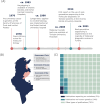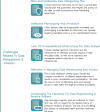Is Tunisia ready for precision medicine? Challenges of medical genomics within a LMIC healthcare system
- PMID: 39080231
- PMCID: PMC11411033
- DOI: 10.1007/s12687-024-00722-x
Is Tunisia ready for precision medicine? Challenges of medical genomics within a LMIC healthcare system
Abstract
As one of the key tools on the precision medicine workbench, high-throughput genetic testing has enormous promise for improving healthcare outcomes. Tunisia has made tremendous progress in acquiring and implementing the technology in the clinical context. However, current utilization does not ensure the whole range of benefits that high-throughput genomic testing provides which impedes the country's ability to move forward into the new era of precision medicine. This issue is primarily related to the current state of Tunisia's healthcare ecosystem and the sociological attributes of its population, creating numerous challenges that must be addressed. In the current review, we aimed to identify and highlight these challenges that may be prevalent in other low and middle-income countries. Essentially, they fall into three main categories that include the socio-economic landscape in Tunisia, which prevents citizens from engaging in precision medicine activities; the current settings of the healthcare system that lack or miss key components for the successful implementation of precision medicine practices; and the inability of the current infrastructure and resources to handle the various challenges related to genomic data and metadata. We also propose five pillar solutions as a framework for addressing all of these challenges, which could strengthen Tunisia's capability for effective precision medicine implementation in today's clinical environment.
Keywords: Genomic testing; High-throughput genetic analysis; Low and middle-income countries; Next generation sequencing; Precision medicine.
© 2024. The Author(s), under exclusive licence to Springer-Verlag GmbH Germany, part of Springer Nature.
Conflict of interest statement
The authors declare no competing interests.
Figures





Similar articles
-
The future of Cochrane Neonatal.Early Hum Dev. 2020 Nov;150:105191. doi: 10.1016/j.earlhumdev.2020.105191. Epub 2020 Sep 12. Early Hum Dev. 2020. PMID: 33036834
-
Genome Tunisia Project: paving the way for precision medicine in North Africa.Genome Med. 2024 Aug 27;16(1):104. doi: 10.1186/s13073-024-01365-w. Genome Med. 2024. PMID: 39187811 Free PMC article.
-
Clinical pharmacogenomics testing in the era of next generation sequencing: challenges and opportunities for precision medicine.Expert Rev Mol Diagn. 2018 May;18(5):411-421. doi: 10.1080/14737159.2018.1461561. Epub 2018 Apr 23. Expert Rev Mol Diagn. 2018. PMID: 29634383 Review.
-
The current and future impact of genome-wide sequencing on fetal precision medicine.Hum Genet. 2020 Sep;139(9):1121-1130. doi: 10.1007/s00439-019-02088-4. Epub 2019 Nov 21. Hum Genet. 2020. PMID: 31754893 Free PMC article. Review.
-
Design and implementation of a scalable high-performance computing (HPC) cluster for omics data analysis: achievements, challenges and recommendations in LMICs.Gigascience. 2024 Jan 2;13:giae060. doi: 10.1093/gigascience/giae060. Gigascience. 2024. PMID: 39172543 Free PMC article.
Cited by
-
Profiles of Monocyte Subsets and Fibrosis-Related Genes in Patients with Muscular Dystrophy Undergoing Intermittent Prednisone Therapy.Int J Mol Sci. 2025 Jun 22;26(13):5992. doi: 10.3390/ijms26135992. Int J Mol Sci. 2025. PMID: 40649771 Free PMC article.
References
-
- Amara A, Adala L, Charfeddine IB et al (2012) Correlation of SMN2, NAIP, P44, H4F5 and occludin genes copy number with spinal muscular atrophy phenotype in tunisian patients. Eur J Paediatr Neurol 16(2):167–174 - PubMed
-
- Anwar WA, Khyatti M, Hemminki K (2014) Consanguinity and genetic diseases in North Africa and immigrants to Europe. Eur J Public Health 24(Suppl 1):57–63 - PubMed
-
- Belal S, Cancel G, Stevanin G et al (1994) Clinical and genetic analysis of a tunisian family with autosomal dominant cerebellar ataxia type 1 linked to the SCA2 locus. Neurology 44(8):1423–1423 - PubMed
Publication types
LinkOut - more resources
Full Text Sources
Research Materials

